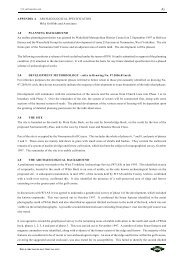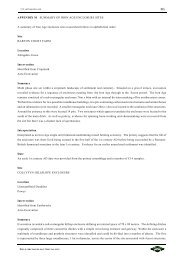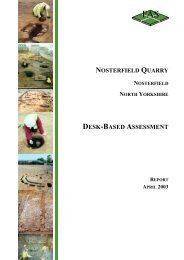ARCHAEOLOGICAL EVALUATION - Mike Griffiths and Associates
ARCHAEOLOGICAL EVALUATION - Mike Griffiths and Associates
ARCHAEOLOGICAL EVALUATION - Mike Griffiths and Associates
Create successful ePaper yourself
Turn your PDF publications into a flip-book with our unique Google optimized e-Paper software.
FAS_lbf01.wpd 84<br />
inherent inaccuracies of plotting from aerial photographs <strong>and</strong> historic maps, there can be little doubt that F5 <strong>and</strong><br />
F6 represent the remains of these post-medieval field boundaries. The fact that any possible continuation of F5<br />
was not defined within Intervention 25 supports this conclusion. F5 <strong>and</strong> F6 do not appear to relate to the<br />
cropmark identified from aerial photography. It seems likely that this cropmark relates to a b<strong>and</strong> of natural<br />
subsoil which has created an area of differential drainage.<br />
8.2.4 Intervention 10<br />
Intervention 10 was located in Zone D adjacent to the southern<br />
boundary of the site (see Figure 36), <strong>and</strong> was also located to<br />
intersect a cropmark feature (see Figure 6). This machine<br />
excavated trench measured 50m x 4m <strong>and</strong> was orientated eastwest<br />
(Plate 10). The ground surface sloped down from 42.25m<br />
AOD at eastern end of the trench to 41.25m AOD at the western<br />
end. The dark yellowish-brown gravel <strong>and</strong> clayey silt<br />
ploughsoil (C1123) was found to be c.0.30-0.40m deep<br />
overlying a light brown silt <strong>and</strong> gravel natural subsoil. The<br />
surface of subsoil reflected the ground level topography.<br />
Plate 10 Intervention 10 looking east (scale<br />
2m)<br />
F7 was first identified as an amorphous deposit of very dark brown clayey silt visible against subsoil 9.6m from<br />
the western end of, <strong>and</strong> positioned centrally within, Intervention 10 (Figure 47). The feature measured c.2.00m<br />
in length by 0.85m in width <strong>and</strong> was orientated approximately NW-SE. Upon excavation, it became clear that<br />
two distinct features were represented; F7 was defined as a large amorphous scoop <strong>and</strong> was cut by a small pit<br />
or posthole at the southeastern end (F11).<br />
F7 proved to be a sub-oval truncated pit or scoop backfilled once with C1117 which consisted of a clean<br />
homogenous brown clayey-silt with frequent gravel <strong>and</strong> occasional charcoal flecks (Figure 48). A small<br />
assemblage of prehistoric pottery was recovered during excavation. Assessment identified the pottery as plain<br />
ware which is broadly dateable to the late Neolithic <strong>and</strong> is often found in association with Grooved ware pottery.<br />
The sherds were thought to represent two, possibly three vessels. Environmental samples were recovered from<br />
F7 <strong>and</strong> flotation produced small fragments of oak <strong>and</strong> non-oak charcoal <strong>and</strong> eight knapping chips. F11 was<br />
defined as a circular deposit of brown clayey-silt measuring 0.30m in diameter. Upon excavation the small<br />
feature proved to be well-defined against the surrounding backfill of F7 <strong>and</strong> only 0.12m deep. It had been<br />
backfilled once with C1121, a brown clayey-silt which contained frequent mixed gravel <strong>and</strong> rare charcoal flecks.<br />
F11 was interpreted as a possible truncated posthole or small pit.<br />
No evidence was found to explain the cropmark feature identified from aerial photography which Intervention<br />
10 was located to investigate.<br />
8.2.5 Intervention 11<br />
Intervention 11 was situated in the southeastern corner of Zone D (see Figure 36). This machine excavated<br />
trench measured 100m x 4m <strong>and</strong> was orientated east-west (Plate 11). The ground surface within the area of the<br />
FIELD ARCHAEOLOGY SPECIALISTS







